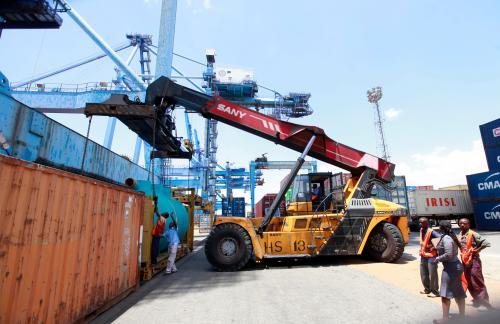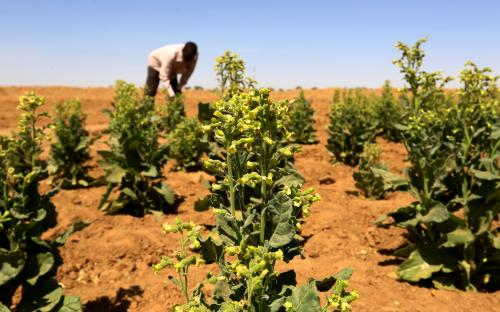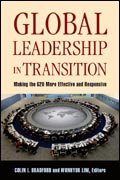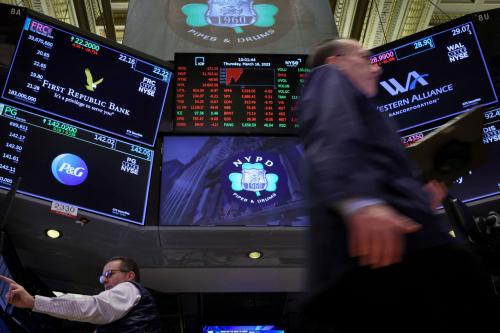Editor’s Note: On July 25, Mwangi Kimenyi testified before the U.S. Senate Committee on Foreign Relations on increasing American jobs through greater U.S.-Africa trade and investment.
Introductory Remarks
Chairman Coons, Ranking Member Isakson, honorable members of the Committee on Foreign Relations, and distinguished members of the Subcommittee, I thank you for this opportunity to highlight the importance of greater U.S. engagement with Africa.
The Africa Growth Initiative (AGI) at the Brookings Institution seeks to articulate informed African voices in Washington with a special focus on relationships between Africa and the United States. A particular focus of AGI’s work has been on evaluating the commercial relations between the United States and Africa. AGI takes the view that the relationship between the United States and Africa should not be defined by a donor-recipient relationship but rather must be based on mutually beneficial engagement. Thus, Senate Bill S.2215, The Increasing American Jobs through Greater Exports to Africa Act of 2012, is consistent with this approach as it highlights the benefits that the United States can secure through greater expansion of trade with the continent.
The United States has been engaging with Africa for a long time. There are clear benefits for this engagement to both Africa and the U.S. in terms of security, commerce and trade. The U.S. has been at the forefront in supporting Africa in form of humanitarian assistance whether in times of natural and/or manmade disasters. The U.S. has also supported Africa in dealing with major health issues such as HIV/AIDS and malaria, and has been involved in various developmental programs that have supported African economies. These initiatives have made a difference in the lives of Africans. However, while it is true that the United States has benefited from its engagement in Africa, the focus of this relationship has been seen as one that mostly benefits Africa often at the expense of American taxpayers. Thus, U.S.-Africa engagement has been defined by some as that of a donor-recipient relationship.
The foundation of this donor-recipient relationship was primarily due to the state of hopelessness that characterized the continent during the first three decades of independence. The period following the independence of many African countries (1960-1980s) is often referred to as the “lost decades” for the continent. This was a period characterized by significant political instability with most of the countries marked by frequent coups and brutal military rule. Those countries not under military rule tended to be single- party, authoritarian regimes that allowed limited expression of voice by the citizenry. On the economic front, the African economies were inefficiently managed and the environment for doing business was extremely poor. The consequence was poor economic performance, corruption, civil wars, and limited human development. These features came to define the relationship between Africa and the international community; during this period, the continent was not seen as a place to invest or do any business, but mainly as a recipient for aid.
But the Africa of the 21st century is different from the one described above. Today, Africa is a land of opportunity both for Africans and the international community. Many commentators have referred to it as “emerging Africa” in recognition of the many changes that have taken place and that continue to take place across the continent. This new Africa calls for a change in the way that the international community, and specifically the United States, engages with it. Towards this end, this testimony focuses on U.S.-Africa engagement, with specific emphasis on why it is crucial for the United States to increase its commercial presence in the continent.
I will organize my remarks into four areas: (1) an overview of Africa’s recent growth and the potential that the continent has for a mutually beneficial relationship with United States; (2) an overview of new partners that are engaging Africa and the implications for the United States; (3) a brief overview of U.S.-Africa commercial relationship to date; and (4) strategies to expand the commerce between the two sides.
Emerging Africa
After decades of poor political governance and economic mismanagement, Africa has changed course and undertaken far reaching political and economic reforms. These changes have yielded handsome returns in the form of economic growth and improved quality of life as measured by various indicators of human development; they have made Africa a more desirable destination for foreign direct investment; and, they suggest that the future growth prospects for most African economies are strong.
Since the middle of the 1990s, Africa growth rates have been high—over 5 percent on average, surpassing most other regions except Asia. Although African economies were affected by the recent global financial volatility and continue to feel the effects of the Eurozone crisis, the economies have shown a high degree of resiliency. For example, analysis by The Economist magazine shows that between 2001 and 2010, Sub-Saharan Africa was home to six of the world’s fastest growing economies with average GDP growth rates above 7.5 percent. These high rates are expected to continue in the coming years. According to the International Monetary Fund (IMF), the predicted economic growth in Africa is expected to show a positive trajectory over the next decade, with average growth rates that surpass most other regions.
Although it is true that commodities have been an important contributor to economic growth, the Africa growth story is not merely that of commodity prices. The core source of the growth is based on fundamental changes that have made the economies more competitive and attractive to investors.
Probably the most significant change in Africa has been the improvement in political governance. Unlike in the past, when Africa was mainly ruled by dictators, many countries have now established democracies that are founded on constitutionalism. While there are weaknesses in many of these democracies, they represent a much better form of governance than was present historically. The governments are more inclusive and have institutionalized mechanisms for holding leaders to account; they are more transparent and less corrupt.
A salutary benefit of improved political governance has been better public policies. Africa’s economies are better managed today than they were in the past—there are less stifling government controls and better monetary and macroeconomic management. For example, African countries now have sustainable domestic debt ratios, helped by a steady decline in the government debt between 2000 and 2011. There is less inflation and more price stability. In addition, there have been marked improvements in the investment climate—simpler licensing and regulatory schemes, predictability in policy, and improved institutional infrastructure and taxation regimes.
The IFC/World Bank report Doing Business 2012 indicates that 36 of 46 governments in Sub-Saharan Africa improved their economy’s regulatory environment for commerce in 2010/11. Of note is that African countries have undertaken far-reaching trade reforms making it much easier to trade across national boundaries. There have been major reforms in the administration of customs, especially in countries that are implementing electronic data management systems. While it is still costly to do business in Africa, the trends in improving the environment for business are encouraging and are expected to make Africa competitive as a destination for investment.
Another important change that has supported economic growth in Africa has to do with advances made in regional integration. Individual African countries have fairly small economies and are not as attractive to investors because of the limited size of their markets. Regional integration is therefore an important strategy for growth as it is associated with larger markets where firms are able to exploit economies of scale. In addition, regional integration lowers the cost of exchange generally by reducing tariffs and other non-tariff barriers across national boundaries. Over the past decade, various regional blocks have made significant progress towards integrating their economies. Many have established a common external tariff and are in the process of implementing various customs union protocols. The African Union is spearheading the establishment of a Continental Free Trade Area (CFTA)—which will likely take a long time to establish—but nonetheless portends well for the future growth of Africa.
In addition to Africa’s economic growth story and the various explanations for growth, there are a number of other changes that have bearing on how the United States engages with Africa. These are detailed below:
- A growing middle class: One of the consequences of the high rates of economic growth in Africa is an increasing consumer middle class. The African Development Bank indicates that the size of this group rose by 60 percent from 2000 to 2010. It represents an important demographic for producers and exporters in the United States to target for the sale of their goods and services.
- Investment opportunities: With the improved environment in terms of doing business, Africa is a much better region to invest in than it was in the past. As a result, investment flows to the region have been increasing – from $9 billion in 2000 to $62 billion in 2008. The rates of return in the region are high, even in comparison to Asia. In addition to investments that exploit the reserves of natural resources, there are many lucrative opportunities to invest in other sectors, such as agriculture and agro-processing.
- Newly discovered natural resources: Natural resources, such as crude oil, have been important drivers for foreign direct investment (FDI) in Africa, and one of the primary reasons that many new players are investing in Africa. Recently, Africa has discovered a great deal of new resources, particularly in Kenya, Tanzania and Mozambique. In these three nations, the U.S. Geological Survey estimates there are over 250 trillion cubic feet of natural gas (in comparison, Nigeria, Africa’s biggest energy producer, has some 186 trillion cubic feet of natural gas). These recent discoveries show that the continent will remain an important source of energy in the near and far future.
- New Partners: Another change that has taken place in Africa is the entry of new partners who have aggressively sought to forge relations in African countries. Their role is discussed in the following section.
Scramble for Africa by New Partners
One of the most significant developments in Africa over the last two decades has been the “new scramble” for the continent. Among the most important of the players in this scramble are the BRICS, specifically Brazil, Russia, India and China (in addition, there are other non-BRIC countries that are increasingly entering African markets, like Iran and Turkey, but they are generally are of lesser importance in this role). While these new players have to some extent been attracted to the continent by the availability of natural resources, their scope of engagement has widened to many aspects of commerce and human development. They have provided Africa with greater opportunities for exports and for aspects of development cooperation, including aid projects and joint business ventures. These new partnerships have been pivotal in sustaining Africa’s growth over the last decade.
Among these new partners, China has been the most aggressive in engaging with Africa. In 1998, its share of exports from Africa was roughly 3 percent; a decade later, by 2008, this figure had grown to 15 percent—and in 2009, it had become Africa’s largest trading partner, overtaking the U.S. in that position. But China has gone to Africa not only in search of natural resources—as some commentators believe—but also to engage Africans in various aspects of development. There are numerous examples that illustrate this point:
- The Government of China is estimated to maintain over 150 commercial attachés and associated staff at its embassies in some 48 African countries. (These figures were determined using publicly available information provided by the Government of China and calculated by colleagues at the Brookings Institution). According to a recent report produced by AGI, there are currently just five U.S. Commerce Department Foreign Commercial Service Officers in Africa and one is set to leave from the embassy in Ghana this summer. Senate Bill S.2215, The Increasing American Jobs through Greater Exports to Africa Act of 2012, proposes to increase this number to fourteen.
- President Hu Jintao has made seven trips to Africa, five as a head of state, and has visited at least 17 countries. More so than the U.S., China holds discussions with African governments, such as the Forum on China-Africa Cooperation (FOCAC), which convene heads of state every three years and is dedicated to enhancing economic, political, and social ties between the two partners.
- China has bilateral agreements with more than 30 African countries that are designed to protect and encourage foreign investment. It has agreements with more than 10 African countries to help investors avoid the issue of “double taxation.” In comparison, the U.S. has bilateral investment treaties (BITs) with only six countries (a seventh is in progress) and trade and investment framework agreements (TIFAs) with eight. AGI has long encouraged the U.S. to establish tax credits for repatriated profits for U.S. businesses in Africa in order to incentivize U.S. firms to invest on the continent.
- The Government of China created the China-Africa Development Fund. This is an equity fund that supports Chinese enterprises investing in Africa; it has existed for three years and has approved over 30 projects, which have spanned a variety of sectors. It is now looking to expand from US $1 billion to US $5 billion.
- China has worked towards the creation of Economic and Trade Cooperation Zones in Africa. It is building six of these zones currently (in countries such as Zambia, Nigeria and Ethiopia). The one in Zambia was China’s first and so far, some 13 companies from a variety of sectors have utilized it. Collectively, they have invested some US $600 million and helped employ 6,000 locals.
China’s engagement with Africa has also actually resulted in African enterprises investing in China. Specific examples include a venture started by a South African enterprise, which produces beer in nearly 70 breweries in China, as well a merged enterprise from Tunisia and China that has become a prominent fertilizer producer in Asia. By the end of 2009, Africa’s total direct investment in China equaled roughly US $10 billion and drew from a wide range of industries: from petrochemical engineering to telecommunications, from textiles to real estate, etc.
These facts and figures are meant to demonstrate the growing importance of the relationship between China and Africa. China is, however, just one among many countries that have ratcheted up commercial interest in the continent. One could similarly expand on India’s role – the country’s commerce and industry minister announced a goal of $90 billion in trade with the continent by 2015 and has stated they will set up an “integrated textile cluster” in Africa that is expected to attract $350 million in investment and provide jobs for around 60,000 people. The takeaway message here is that competition to do business in the Africa has intensified and the United States should take note of these developments in formulating its own engagement strategy.
U.S.-Africa Commercial Relations
The African Growth and Opportunity Act
The African Growth and Opportunity Act (AGOA) remains the most important piece of legislation as far as the U.S.-Africa commercial relationship is concerned. The Act provides for duty- and quota-free access to American markets for many goods from Sub-Saharan Africa. Since its enactment into law in 2000, African exports to the United States increased steadily until 2008 when they experienced a sharp drop, but have since started to recover in 2010. Data from a recent AGI report, entitled The Africa Growth and Opportunity Act (AGOA): Looking Back, Looking Forward by Witney Schneidman and Zenia A. Lewis, examines the trends in depth and provides the foundation for this section of testimony.
Exports from AGOA beneficiaries were $53.8 billion in 2011. This represents a 21.5 percent increase in AGOA exports from 2010 and a more than 500 percent increase from the initial $8.15 billion in AGOA exports in 2001 (shown in the appendix). Mineral fuels and crude oil drove this increase and accounted for 91.6 percent of AGOA exports in 2011 (shown in the appendix). AGOA’s share of total U.S. imports, although still relatively small as an aggregate number, grew from 0.7 percent to 2.5 percent during this 10-year period. During the last 10 years, on average, more than 70 percent of Sub-Saharan Africa’s exports to the U.S. have enjoyed duty-free status under AGOA or the Generalized System of Preferences (GSP).
Over the course of the decade, petroleum products accounted for roughly 89 percent of AGOA imports, though they would have entered the U.S. duty-free under GSP even without AGOA. Nonetheless, oil imports underscore the growing importance of Sub-Saharan Africa as a source of imported energy resources. For example, Angola and Nigeria have consistently accounted for about 10 percent of U.S. imported oil during the last decade. Moreover, given the recent discoveries of oil in other countries in the Gulf of Guinea, U.S. reliance on imported oil from Sub-Saharan Africa will likely continue to grow. It should be noted that the region provides a proportion of U.S. oil imports comparable to the Middle East (in fact, it was slightly higher in 2010). In addition, the quality of West Africa’s crude oil and the region’s proximity to the eastern United States have made the region one of increasing strategic significance for the U.S.
AGOA’s nonpetroleum exports showed steady growth between 2001 and 2011, virtually tripling from about $1.2 billion to $4.5 billion, and peaking at $4.7 billion in 2008. In the early years of AGOA, the number of countries and the variety of sectors reflected in the nonpetroleum exporter group were small. In AGOA’s first year, only 13 of the 34 eligible countries exported nonpetroleum products to the U.S. through the legislation; now this number stands at 22.
Textile and apparel accounted for more than $850 million in 2011, which was more than double the level of 2001, although a decline from a peak of more than $1.6 billion in 2004 (shown in the appendix). Transportation equipment imported under AGOA, mostly automobiles from South Africa, grew from $296 million in 2001 to $2.1 billion in 2011.
The capacity of Africans to export apparel and textiles to the United States has been boosted by the Third Country Fabric provision, which allows for duty-free status for apparel exports made from fabric that is sourced from third countries. Without this provision, which is still set to expire in September 2012, many African countries would not be able to export apparel to the U.S. It has been very important for countries including Mauritius, Lesotho, Swaziland and Kenya, which export the largest percentage of apparel and textiles to the U.S. (Smaller suppliers of apparel products include Botswana, Malawi, Ethiopia, South Africa, Tanzania and Ghana.)
It is estimated that AGOA has helped in the direct creation of 300,000 jobs in Africa, many of which are in the textile sector and have gone to women. In addition, according to Paul Ryberg of the African Coalition for Trade, the legislation has also succeeded in indirectly creating 1.3 million jobs.
But AGOA has also not realized its full potential. Only a relatively small fraction of the available product lines available under AGOA have been exploited—primarily due of the limited diversification in the African countries. It has also not spurred American investments in Africa, as once hoped. U.S. investments in the continent remain low (although they have shown some increase). America’s investment position in Sub-Saharan Africa is less than 1 percent of its direct investment worldwide.
Increasing support both to African countries and to American firms investing in Africa could significantly bolster the commercial relationships between the two sides. The agencies of the U.S. Government that have played and could play an increased role in supporting U.S.-Africa trade include the Commerce Department, the United States Agency for International Development (USAID), the United States Department of Agriculture (USDA), the Export-Import Bank (Ex-Im) and the Overseas Private Investment Corporation (OPIC). Below, I briefly highlight the role and status of a couple of these agencies as related to the U.S.-Africa commercial presence.
Department of Commerce: During the past several years, the Foreign Commercial Service (FCS) of the Commerce Department has substantially reduced its presence in Africa and its ability to support American business. AGOA originally directed the Commerce Department to ensure there were at least 20 full-time FCS officers stationed in 10 Sub-Saharan African countries. Currently, there are only five officers in the region, in Ghana, Kenya, Nigeria, and South Africa (where there are two). The FCS has closed its offices in Dakar, Abidjan and Durban and, according to U.S. government officials, the FCS officer in Accra will not be replaced once he departs in the summer of 2012. The Commerce Department there will be staffed only with locally hired people, as is the practice in Cape Town for several years. Although locally hired staff are important for understanding and engaging the local market, there is no substitute for career FCS officers supporting and implementing U.S. commercial diplomacy. Therefore, the Department of Commerce should put a higher priority on staffing its FCS in African countries. As mentioned previously, the U.S. is lagging far behind countries like China with regard to this issue.
United States Export-Import Bank (Ex-Im): Although the Commerce Department has pulled back from Africa, the U.S. Export-Import Bank has become increasingly aggressive there. One of its main tasks is to promote U.S. trade with the region and if recent history is any indication, it seems to be doing well. Between 2009 and 2011, the value of transactions supported by Ex-Im increased from $412 million to $1,392 billion—a record level for the agency—and from 132 to 179 transactions. In terms of coverage, Ex-Im financed exports to 31countries in Sub-Saharan Africa in 2011. The majority of these exports were relatively small transactions under $200 million. Large transactions—such as support for Boeing aircraft to Rwanda and Angola, and GE locomotives to Transnet in South Africa—account for the lion’s share of Ex-Im’s financial portfolio in the region. Of the 49 countries in the region, Ex-Im is open in 43 countries in the short term, 29 countries in the medium term, and 19 countries in the long term. Globally, Ex-Im supports about 4 percent of U.S. exports through its various programs, and in Sub-Saharan Africa, it supports about 8 percent of U.S. exports.
The agencies discussed above have an important role to play in any legislation that seeks to increase commercial engagement between Africa and the United States. The Department of Commerce and Ex-Im, along with USAID, USDA and OPIC, could do more to support both African exports and to strengthen the U.S. commercial presence in Africa.
Senate Bill S.2215: The Increasing American Jobs through Greater Exports to Africa Act
The proposed legislation Increasing American Jobs through Greater Exports to Africa Act takes note of the potential benefits that engagement with Africa offers the U.S. The legislation targets increasing exports of U.S. goods and services to Africa by 200 percent in real dollar value within 10 years. To achieve this target, it calls for improving the competitiveness of U.S. businesses in Africa and seeks to educate American businesses on the potential that Africa holds as a market for U.S. products. Among other provisions, the legislation calls on the Export-Import Bank to utilize its profits to assign no fewer than three of its full-time employees to U.S. embassies in Africa and to increase funding for U.S.-Africa projects.
The proposed Act provides a necessary direction for U.S. engagement, but could be expanded. The increase of 200 percent in exports to Africa over 10 years is modest. Given the changes taking place in Africa in terms of economic growth and the rise of the middle class, an increase of 200 percent appears somewhat understated. When this is compared to China’s exports to Africa (which have increased around 700 percent between 2002 and 2011) it is apparent that the target could be much higher. (For recent historical perspective on the matter, see the appendix). Current rates of American exports to Africa are estimated to support 100,000 U.S. jobs.
But the Act is to be commended for calling for a different approach in the way the United States engages with Africa. It starts with the premise that the continent offers many opportunities that can be exploited for the benefit of both Africans and non-Africans. Furthermore, the legislation recognizes the importance of the BRICs in the African market and recognizes that one of the reasons why businesses from these countries have been able to penetrate the market as successfully as they have is because they have received significant support and encouragement from their home governments. In response, the legislation appropriately calls for more support of American firms that seek to do business in Africa.
The legislation also requires that at least 25 percent of the projects financed by the Export-Import Bank take place in Africa. Ex-Im has significantly increased its efforts on the continent recently, but the efforts of analogous banks in countries like China are still far out-pacing it. This aspect of the legislation is an important step in helping the U.S. become more competitive in the region.
Another key aspect of this legislation is the call for the White House to create a coherent trade and investment strategy for enhancing American business in Sub-Saharan Africa and to designate an individual to carry out this strategy. As noted above, AGOA has been very important in redefining the U.S.-Africa commercial relationship; the proposed Act, however, does not reference how it will work in coordination with AGOA to be part of a broader trade and investment strategy. It is important to include a discussion of this type in the legislation.
Concluding Remarks
I would like to thank again the Chairman, Ranking Member, and honorable members of the Committee on Foreign Relations for this opportunity to highlight the importance of greater US engagement with Africa.
My testimony has tried to illustrate a number of points. The first is that the United States should transition away from the type of a donor-recipient engagement it has with Africa towards a relationship that is more mutually beneficial. This change in paradigm has been made possible by the fact that Africa has, in many parts of the continent, turned a corner in its effort to develop its economies and political structures. Over the last two decades, its countries have instituted major political and economic reforms, which have resulted in a more stable environment and have produced stronger economic policies. These reforms are, in part, responsible for the high rates of economic growth and the new business opportunities sprouting up throughout the continent.
This new climate has caught the attention of many non-African countries. China, in particular, has redoubled its efforts to engage economically with the continent. Its exports to Africa have increased by more than 700% between 2002 and 2011, and it is estimated the country has over 150 commercial attachés and associated staff in the 48 African countries. However, as China and other nations increase the scope of their engagement with Africa, the relative importance of the U.S.’ commercial engagement with the continent has remained unchanged. For example, the value of its total exports, in contrast, has remained basically constant. Additionally, it has stationed only five Foreign Commercial Service Officers within Africa.
The most significant piece of U.S. legislation defining the U.S.-African commercial relationship is the Africa Growth and Opportunity Act (AGOA); and it is quite a success story. Over the last 12 years, it has been responsible for increasing African exports to U.S. markets significantly and for creating at least 300,000 jobs in Africa. But its full potential has not yet been realized: it has not spurred American investments in Africa as much as initial hopes suggested it would.
The proposed legislation, the Increasing American Jobs through Greater Exports to Africa Act of 2012, seeks to complement AGOA. It appropriately calls for more support to American firms seeking to engage with Africa. Such support is critically important if the U.S. economy is to benefit from Africa’s economic rise as much as it can and should.
Recommendations:
- The U.S. should extend the Third Country Fabric Provision. It has been instrumental in allowing African producers to export apparel to the United States. It is critical that this provision, which is set to expire in September 2012, be extended as soon as possible.
- The U.S. government should do much more to support American firms that seek to do business in Africa. Creating better incentives for such companies (possibly in the form of tax reductions on repatriated profits or higher levels of financing from U.S. government agencies, etc.) should be considered options.
- The proposed legislation mandates an increase in U.S. exports to Africa by at least 200% over the next 10 years. Given the economic performance predicted for Africa over this time-span, this figure should be revised upwards.
- More commercial attachés should be dispatched by U.S. agencies to Africa, commensurate to the potential level of benefit the U.S. could reap by such engagement.
- More high-level discussions regarding economic engagement should be scheduled and held between the two sides, especially ones in which U.S. businessmen are able to participate.
- Finally, the proposed legislation should identify synergies between it and AGOA which could be exploited so as to deepen U.S. engagement with Africa and to create a broader strategy for action regarding the continent.
Appendix: Supporting Charts and Graphs for Mwangi S. Kimenyi’s statement on Economic Statecraft: Increasing American Jobs through Greater U.S.-Africa Trade and Investment





*Thank you to Andrew Westbury, Brandon Routman, Jessica Smith and Zenia A. Lewis for research assistance with this testimony.









Commentary
TestimonyEconomic Statecraft: Increasing American Jobs through Greater U.S.-Africa Trade and Investment
July 25, 2012